Posted by Elena del Valle on February 4, 2013
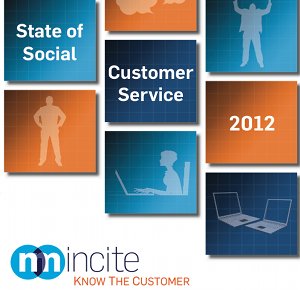
State of Social Customer Service Report 2012
In July 2012, NM Incite, a joint venture between Nielsen and McKinsey & Company dedicated to measurement science and management consulting, surveyed a representative group of 2,000 United States social media users 18 and older using Nielsen’s online panel. In the eight-page State of Social Customer Service Report 2012, they concluded, among other things, that 47 percent of all social media users have used social care, a system for companies to provide customer service in social media platforms. Such usage crossed ages and genders among survey responders and was as high as 60 percent among women 18 to 24 years of age.
Based on the responses to the survey they believe 71 percent of those who said they experience positive social care, meaning a speedy and effective response, said they are likely to recommend that brand to others, compared to 19 percent of customers who said they had had no response. Also, the researchers estimated that nearly one in three social media users preferred to contact customer service through a social media channel instead of calling.
The survey staff found that more than half of social media users 45 and younger said they take advantage of social care. At the same time, those who went to social media to share their gripes or questions wanted responses in their channel.
They also concluded that one negative experience with customer service shared in a public forum could void the effect of five positive customer messages. More than half (51 percent) of people who said they rely on social care said they engage with brands several times each month and 9 percent said they engage daily.
Posted by Elena del Valle on January 14, 2013

23 percent said they read ebooks
Photos: HispanicMPR
Selling a book? Thinking of becoming an author? You may be in luck. It seems many Americans are reading books. Whether it’s printed books, purchased or borrowed e-books (from the library) reading is popular. At the end of last year, 75 percent of Americans 16 and older said they read books, according to a Pew Research Center’s Internet & American Life Project phone survey of 2,252 people 16 years and older, and a related article by Lee Rainie and Maeve Duggan. Those numbers represent a 3 percent decline compared to 2011 when 78 percent of survey takers said they read books.
A closer look reveals an increase in e-book readers with 23 percent of survey takers 16 and older saying they read e-books, up from 16 percent the previous year; and 13 percent of them said they had listened to an audio book. It’s no wonder since the percent of survey takers who own a book reading device (tablet, computer or e-book reader) went from 18 percent in 2011 to 33 percent in 2012.

14 percent said they read 21 or more books
The increase in e-book readers between 2011 and 2012 was 11 percent among non Hispanic blacks, 10 percent among non Hispanic whites and 5 percent among Hispanics. Print book reading dropped from 72 percent to 67 percent over the same time period, according to the same Pew data.
In the past year, 7 percent of survey takers said they had read one book; 12 percent said they had read four to five books; 13 percent said they had read eleven to twenty books; and 14 percent indicated they had read 21 or more books. The mean number of books read by women was 17 compared to 13 by men. The most likely e-book readers? People between 30 and 49 with college or graduate degrees and those who live in households with an income of more than $75,000.
Posted by Elena del Valle on January 7, 2013
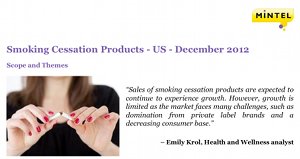
Sales of smoking cessation products may increase 3 percent from 2011-12 and reach $1 billion and growth is expected through 2017 reaching $1.2 billion in sales, according to Smoke Cessation Products US December 2012, a Mintel report. The odds of kicking the habit may be against the average smoker. According to the Mayo Clinic website, only 5 percent of people who try to quit tobacco succeed on their own without a quit-smoking product. The site indicates more than 30 percent “can succeed when using a quit-smoking product.”
It seems some smokers who want to quit fear gaining weight during the quitting process. Forty one percent of respondents to a Mintel survey, conducted online in English December 2012, who have previously quit or are interested in quitting, said gaining weight was their biggest challenge to quitting smoking; 54 percent of those were women and 31 percent were men.
Hispanic respondents to the survey were more likely to smoke than other respondents. Those who smoked appeared more likely to be trying to stop. Mintel staff believes smoking cessation product marketers might consider Hispanic specific outreach.
Hispanic smokers trying to quit who responded to the survey said they were influenced by their friends in their desire to stop smoking. This led Mintel staff to suggest the possibility of marketing program activities with smokers friends.
Hispanic respondents who had quit or wanted to quit were less likely to say that they look for smoking cessation products that are not expensive. At the same time they were also less likely to say the cost of cigarettes influenced their behavior.
Posted by Elena del Valle on January 1, 2013

As the past year ends and a new one begins we take the opportunity to thank you for following our articles, podcast interviews, emails and Tweets, for sharing your comments, ideas and suggestions, and working with us to make our content interesting and relevant. And to wish you a healthy and prosperous 2013!
Posted by Elena del Valle on December 3, 2012
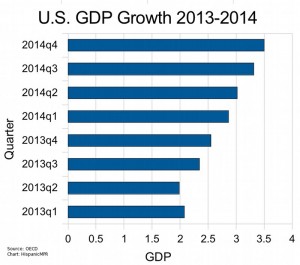
U.S. GDP Growth 2013-14 – click to enlarge
Assuming fiscal cliff issues are overcome the economy will continue a steady recovery over the coming two years, according to researchers at Organization for Economic Co-operation and Development (OECD). Our GDP is projected to grow 2 percent next year and 2.8 percent in 2014. Compared to Europe, estimated to remain in a recession and contract through the end of 2012 and into 2013 before reaching a GDP growth of 1.3 percent, the projections for the United States seem positive. Even when compared with GDP growth across the OECD of 1.4 percent for 2013 and 2.3 percent for 2014, the expectations of the United States appear promising.
“The world economy is far from being out of the woods,” said Angel Gurría, secretary-general, OECD during the Economic Outlook launch in Paris last week. “The US ‘fiscal cliff’, if it materialises, could tip an already weak economy into recession, while failure to solve the euro area crisis could lead to a major financial shock and global downturn. Governments must act decisively, using all the tools at their disposal to turn confidence around and boost growth and jobs, in the United States, in Europe, and elsewhere.”
With 50 million jobless people in the OECD area, according to the Outlook it’s no wonder the OECD head expressed concern. The report indicated continued high in employment with a possible rise in many countries “unless structural measures are used to boost near-term employment growth.”
Some developing countries, on the other hand, show desirable growth for the coming twenty four months. China is expected to grow at 8.5 percent next year and 8.9 percent the year after that. Other countries expected to grow at healthy rates are Brazil, India, Indonesia, Russia and South Africa.
Slides of the presentation are available at http://www.slideshare.net/OECD/oecd-economicoutlook92%20 on the OECD website. The mission of the Organisation for Economic Co-operation and Development is to promote policies that will improve the economic and social well-being of people around the world.
Posted by Elena del Valle on November 12, 2012
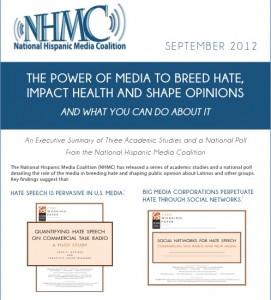
Earlier this year the National Hispanic Media Coalition (NHMC) released the findings of academic studies and a national poll that outline the role of the media in “breeding hate and shaping public opinion about Latinos and other groups.” The organization’s leadership believes the research presented “underscores the need for accuracy and fairness in our media.”
The research indicates that hate speech on commercial talk radio has led to social network interest in the radio program hosts and their guests; and that this social network passes its content to affiliated social media websites, resulting in voices promoting hatred toward people of color, people of certain religions and LGBT people. According to the report, “Media personalities and political figures representing the Republican Party and/or affiliated with the Tea Party dominate the social network, leaving little room for alternate points of view. Media powerhouses such as Premiere Radio Networks, a wholly-owned subsidiary of Clear Channel Communications, and Fox News are key components of this social network.”
A poll of non-Latino Americans found that their source of news is often television. Sixty six percent of respondents to the poll said they watch major network and cable newscasts for information and 30 percent said they trust Facebook, Twitter, and other social networks or online-only news sources. These individuals rely on news and entertainment media in forming impressions about Latinos and immigrants, according to poll analysts. The poll led researchers to conclude that Latinos and immigrants are commonly portrayed negatively in news and entertainment media prompting many non-Latinos to believe that “media-promoted negative stereotypes about these groups are true.”
The poll analysis indicates that conservative talk radio and Fox News audiences while less likely to be personally familiar with Latinos are more likely to hold anti-immigrant and anti-Latino views. Some survey respondents erroneously, according to the executive summary, believe that Latinos and undocumented immigrants are the same, and 17 percent of survey respondents said they believe that the majority of United States Latinos are undocumented.
The results of the studies were published in the UCLA Chicano Studies Research Center. They are: Quantifying Hate Speech on Commercial Talk Radio from November 2011, Social Networks for Hate Speech Commercial Talk Radio and New Media from July 2012 by Chon A. Noriega, director, UCLA Chicano Studies Research Center, and Francisco Javier Iribarren and Using Biological Marketers to Measure Stress in Listeners of Commercial Talk Radio by Hermes J. Garban, Iribarren and Noriega.
The UCLA Chicano Studies Research Center supports interdisciplinary, collaborative, and policy-oriented research. The W.K. Kellogg Foundation provided support to make the research possible. Matt A. Barreto, Sylvia Manzano, and Gary Segura of Latino Decisions produced and designed the research study, and implemented the data collection. The National Hispanic Media Coalition was founded in 1986 to increase positive portrayals of Latinos in media, based on a fundamental understanding that the media has the power to shape opinions of and behavior towards Latinos and other demographic groups.
Posted by Elena del Valle on October 31, 2012

Seleccion Tequila
Photos: Casa Herradura
Tough economic times are not dampening the spirit of fine tequila drinkers. Just in time for the holiday season tequila maker Casa Herradura recently announced new refined primary and secondary packaging for its high-end, extra añejo Selección Suprema tequila, first produced in 1995, designed to appeal to tequila connoisseurs and aficionados among men thirty years of age and older.
A brand spokesperson described the target customers as “sophisticated males who appreciate Herradura and the desire to share the best life has to offer with closest friends.” The 750 milliliter bottle sells for $350. The new packaging was expected to arrive at stores by the end of October.

Seleccion Tequila – click to enlarge
“The refinements are meant to better reflect the quality and sophistication of the tequila within and align the packaging with the rest of the Herradura brand family,” said Valdemar Cantu, brand manager Herradura.

Seleccion Tequila bottle and box
The new package features an earth-tone box with a bi-fold opening with the brand’s horseshoe on the bottom right panel. The center interior of the box props and cradles the bottle on a fitted pedestal. The new packaging was designed by Johnny Cardenas, design director for Brown-Forman. Once opened, the bi-fold panels display the story of the tequila handcrafted in Amatitán, Jalisco Mexico following “traditional production methods” and aged for 49 months in American white oak barrels. Although the glass container remains unchanged, a copper finish metal die cast horseshoe, a copper neck band, and a brand mark update were added as well as an authenticating strip label signed by Master Distiller Maria Teresa Lara.
Casa Herradura has been hand harvesting, handcrafting and estate bottling tequilas in Jalisco, Mexico since 1870. In 2007, Casa Herradura was acquired by Brown-Forman Corporation of Louisville, Kentucky. Brown-Forman is a producer and marketer of beverages and alcohol brands.
Posted by Elena del Valle on October 29, 2012

Border Patrol officers use All Terrain Vehicles to patrol the border with Mexico
Photo: U.S. Department of Homeland Security
In the first half of this year more people entered the United States illegally through Mexico and fewer migrants returned to Mexico, according to researchers on both sides of the border. Such traffic numbers were unusual in that 2007 was the last time researchers saw growth in border crossing numbers toward the United States.
Staff at The Mexican Migration Monitor, a joint project of The Colegio de la Frontera Norte and the Tomas Rivera Policy Institute at the University of Southern California, estimate there are some 11.7 million Mexican born people living in the United States including documented and undocumented immigrants. That number may increase slightly by the end of the year, according to the two organizations. The principal investigators of the Monitor are Roberto Suro and Rene Zenteno. The academics rely in part on the Border Survey of Mexican Migration said to be “the oldest continuous research program tracking original data on the number of people crossing the U.S.-Mexico border, with the objective of providing unbiased estimates of Mexican labor flows.”
They believe that the numbers indicate the size of the Mexican-born population in the United States has fully recovered from the decreases caused by or following the Great Recession. Recently, unemployment among those migrants, they point out, has dropped and labor force participation rates have held up indicating that the economic performance of the undocumented immigrants from this group may be slightly better than for native-born workers in the United States.
Another indicator considered by researchers of Mexico to United States border crossing and economic trends is the transfer of money from Mexicans in the United States to relatives in Mexico. The researchers have concluded that remittance levels have recovered lost ground following two years of growth post Great Recession.
Posted by Elena del Valle on October 1, 2012

Espresso-based beverages are popular among Hispanics
Photo: HispanicMPR
Hispanics like to drink coffee more than other racial and ethnic groups. They begin drinking coffee earlier than other groups and in their older years are more likely to be exclusive coffee drinkers; and 74 percent of Hispanic-Americans drink coffee daily, twelve percentage points ahead of other Americans. As they become acculturated they mimic the attitudes and behaviors of non Hispanic coffee drinkers, according to Ethnicity and Coffee: Focus on Hispanic-American and African-American Coffee Consumption Across the U.S. Market, a new study by the National Coffee Association, part of the organization’s NCA Market Research Series.
The study examined coffee consumption on a past-day, past-week and past-year basis. The researchers concluded Hispanic American respondents were more likely than Caucasians and African Americans to consume coffee on a past-day, past-week and past-year basis.
Hispanic American respondents to the survey were more likely compared to Caucasian and African American respondents to drink decaffeinated coffee and espresso-based beverages on a past-day basis. On a past-week and past-year basis, Hispanic American consumers were more likely compared to Caucasians and African Americans, to drink espresso-based beverages. The interviews led the Association researchers to the conclusion that higher past-week penetration among Hispanic Americans is driven by cappuccino and espresso; and that they are more likely to consume both of these beverages on a past-week basis.
The Association surveyed 2,955 Hispanic, Caucasian, African American and Asian and Other individuals. In order to be certain of the tastes and behaviors of Hispanics that group was over represented; one thousand Latinos were interviewed. To make sure the over representation did not bias the results when the researchers profiled the overall population the final dataset was weighted based on age, gender, region and ethnicity to match the U.S. population based on the 2010 U.S. census.
The breakdown by country of origin or geographic area among the Hispanics interviewed for this project was: from Mexico (502), Other (137), Puerto Rico (132), Cuba (81), and Dominican Republic (52). By language preference (defined as level of acculturation by the researchers): Spanish Dominant (336), Bilingual (312) and English Dominant (269).
The National Coffee Association of U.S.A, Inc. (NCA), established in 1911, is a trade organization for the coffee industry in the United States. Its leaders strives to serve all segments of the domestic coffee industry, including traditional and specialty companies. A majority of NCA membership, which accounts for over 90 percent of United States coffee commerce (according to the organization website), is comprised of small and mid-sized companies and includes growers, roasters, retailers, importer, exporters, wholesaler, suppliers and allied industry businesses.
Posted by Elena del Valle on September 24, 2012
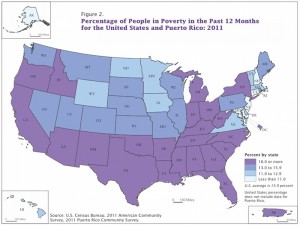
U.S. Poverty by State 2011 – click to enlarge
Graphic: U.S. Census Bureau American Community Survey 2011
Median household income remained mostly unchanged between 2010 and 2011 in 32 states and the District of Columbia, according to the U.S. Census report Household Income for States: 2010 and 2011. Last year, median household income ranged from $36,919 in Mississippi to $70,004 in Maryland.
The median household income nationally was $50,502. It was lower than the national median in 27 states and higher in 19 states and the District of Columbia. North Dakota, Wisconsin, Nebraska and Pennsylvania median household incomes did not have a statistically significant difference from the U.S. as a whole.
Poverty numbers, unlike median household income numbers, increased in 17 states for the same time period according to the report Poverty: 2010 and 2011, which compares poverty rates in 2010 and 2011 for the nation, states and large metropolitan areas. At the state level, New Hampshire (8.8 percent) had the lowest poverty rate, and Mississippi (22.6 percent) had one of the highest poverty rates. The map above illustrates how most of the bottom half of the country, marked in purple, has a high percent of poverty.
In metro areas with populations of 500,000 or more, poverty rates ranged from a low of 8.3 percent in the Washington metro area, to 37.7 percent in McAllen-Edinburg-Mission, Texas. For 10 states, this was the third consecutive annual increase in the number and percentage of people in poverty.
In five states, the number of people in poverty increased but the poverty rates did not go up. Between the 2010 and 2011 American Community Survey, the percentage and number of people in poverty in Vermont declined.






















